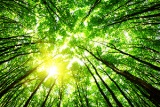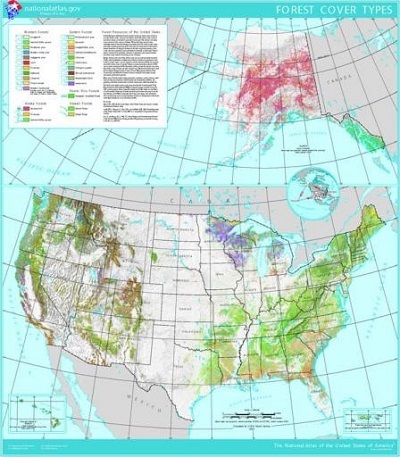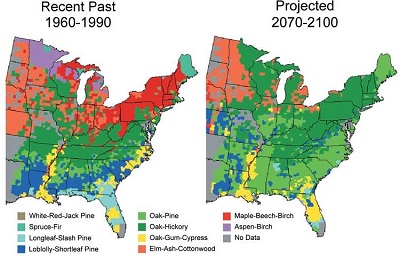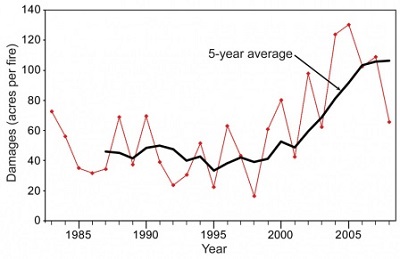|
|
| |
|
|
| |
|
|
|
|
| |
 Climate
Impacts on Forests Climate
Impacts on Forests
Overview
In the United States, forests occupy approximately 740
million acres, about one third of the country's total land
area. America's forests provide many benefits and services
to society, including clean water and air, recreation,
wildlife habitat, carbon storage, climate regulation, and a
variety of forest products. Climate influences the structure
and function of forest ecosystems and plays an essential
role in forest health. A changing climate may worsen many of
the threats to forests, such as pest outbreaks, fires, human
development, and drought. |
 Climate
changes directly and indirectly affect the growth and
productivity of forests through changes in temperature,
rainfall, weather, and other factors. In addition, elevated
levels of carbon dioxide have an effect on plant growth.
These changes influence complex forest ecosystems in many
ways. Climate
changes directly and indirectly affect the growth and
productivity of forests through changes in temperature,
rainfall, weather, and other factors. In addition, elevated
levels of carbon dioxide have an effect on plant growth.
These changes influence complex forest ecosystems in many
ways.
Picture - Extent and
type of forest cover in the United States. View larger: U.S.
Forest Service, National Atlas.
In conjunction with the projected impacts of climate change,
forests face impacts from land development, suppression of
natural periodic forest fires, and air pollution. Although
it is difficult to separate the effects of these different
factors, the combined impact is already leading to changes
in our forests. As these changes are likely to continue in
the decades ahead, some of the valuable goods and services
provided by forests may be compromised. To learn more about
examples of projected regional changes in forests, see the
Northeast, Southeast, Southwest, and Alaska regional impacts
pages. |
|
 Impacts
on Forest Growth and Productivity Impacts
on Forest Growth and Productivity
Many aspects related to climate change are likely to affect
forest growth and productivity. Three examples are described
below: increases in temperature, changes in precipitation,
and increases in carbon dioxide (CO2).
Picture - Projected
shifts in forest types. The maps show recent and projected
forest types. Major changes are projected for many regions.
For example, in the Northeast, under a lower emissions
scenario, the currently dominant maple-beech-birch forest
type (red shading) is projected to be displaced by the
oak-hickory forest type in a warmer future. Source: USGCRP
(2009)
Warming temperatures generally increase the length of the
growing season. It also shifts the geographic ranges of some
tree species. Habitats of some types of trees are likely to
move north or to higher altitudes. Other species will be at
risk locally or regionally if conditions in their current
geographic ranges are no longer suitable. For example,
species that currently exist only on mountaintops in some
regions may die out as the climate warms since they cannot
shift to a higher altitude.
Climate change will likely increase the risk of drought in
some areas and the risk of extreme precipitation and
flooding in others. Increased temperatures alter the timing
of snowmelt, affecting the seasonal availability of water.
Although many trees are resilient to some degree of drought,
increases in temperature could make future droughts more
damaging than those experienced in the past. In addition,
drought increases wildfire risk, since dry trees and shrubs
provide fuel to fires. Drought also reduces trees' ability
to produce sap, which protects them from destructive insects
such as pine beetles.
Carbon dioxide is required for photosynthesis, the process
by which green plants use sunlight to grow. Given sufficient
water and nutrients, increases in atmospheric CO2 may enable
trees to be more productive, which may change the
distribution of tree species. Growth will be highest in
nutrient-rich soils with no water limitation, and will
decrease with decreasing fertility and water supply. |
|
 Impacts
of Disturbances Impacts
of Disturbances
Climate change could alter the frequency and intensity of
forest disturbances such as insect outbreaks, invasive
species, wildfires, and storms. These disturbances can
reduce forest productivity and change the distribution of
tree species. In some cases, forests can recover from a
disturbance. In other cases, existing species may shift
their range or die out. In these cases, the new species of
vegetation that colonize the area create a new type of
forest.
Picture - The brown
and red trees in this picture have been infested by mountain
pine beetles near Winter Park, Colorado in May 2007. Source:
CCSP (2008)
Insect outbreaks often defoliate, weaken, and kill trees.
For example, by 2007, pine beetles had damaged more than
650,000 acres of forest in Colorado and spruce beetles had
damaged more than 3.7 million acres in southern Alaska and
western Canada. The hemlock woolly adelgid, an invasive
species that is sensitive to cold weather and destroys
Eastern hemlock, will likely extend its habitat north as the
climate warms. A lack of natural controls, such as
predators or pathogens, as well as inadequate defenses in
trees, can allow insects to spread. Climate change could
contribute to an increase in the severity of future insect
outbreaks. Rising temperatures may enable some insect
species to develop faster, alter their seasonal life cycles,
and expand their ranges northward. Invasive plant species
can displace important native vegetation because the
invasive species often lack natural predators. Climate
change could benefit invasive plants that are more tolerant
the environmental conditions resulting from climate change
than are native plants. |
 In
2011, wildfires consumed more than 8 million acres of forest
in the U.S. (an area roughly the size of Maryland), causing
15 deaths and more than $1.9 billion in damages. Warm
temperatures and drought conditions during the early summer
contributed to this event. Climate change is projected to
increase the extent, intensity, and frequency of wildfires
in certain areas of the country. Warmer spring and summer
temperatures, coupled with decreases in water availability,
dry out woody materials in forests and increase the risk of
wildfire. Fires can also contribute to climate change, since
they can cause rapid, large releases of carbon dioxide to
the atmosphere. In
2011, wildfires consumed more than 8 million acres of forest
in the U.S. (an area roughly the size of Maryland), causing
15 deaths and more than $1.9 billion in damages. Warm
temperatures and drought conditions during the early summer
contributed to this event. Climate change is projected to
increase the extent, intensity, and frequency of wildfires
in certain areas of the country. Warmer spring and summer
temperatures, coupled with decreases in water availability,
dry out woody materials in forests and increase the risk of
wildfire. Fires can also contribute to climate change, since
they can cause rapid, large releases of carbon dioxide to
the atmosphere.
Picture - This figure
shows annual wildfire-burned area (in millions of acres)
from 1983 to 2015. (The two lines represent two different
reporting systems, shown for comparison). The extent of area
burned by wildfires each year appears to have increased
since the 1980s. According to National Interagency Fire
Center data, of the 10 years with the largest acreage
burned, nine have occurred since 2000, including the peak
year in 2015. This period coincides with many of the warmest
years on record nationwide. Source: Climate Change
Indicators in the United States
Hurricanes, ice storms, and wind storms can cause damage to
forests. Hurricanes Rita and Katrina in 2005 damaged a total
of 5,500 acres of forest. The amount of carbon released by
these trees as they decay is roughly equivalent to the net
amount of carbon sequestered by all U.S. forests in a single
year.
Disturbances can interact with one another, or with changes
in temperature and precipitation, to increase risks to
forests. For example, drought can weaken trees and make a
forest more susceptible to wildfire or insect outbreaks.
Similarly, wildfire can make a forest more vulnerable to
pests. The combination of drought and outbreaks of beetles
has damaged piñon pine forests in the Southwest. |
|
|
EPA Page |
|
This is the
EPA page for this topic. To see if the Trump
administration has changed the EPA page, simply click the
link and compare the information with this page. If you
notice changes were made to the EPA page, please post a
comment. Thanks. |
|
|
Key Points
Climate change will likely alter the frequency and intensity
of forest disturbances, including wildfires, storms, insect
outbreaks, and the occurrence of invasive species.
The productivity and distribution of forests could be
affected by changes in temperature, precipitation and the
amount of carbon dioxide in the air.
Climate change will likely worsen the problems already faced
by forests from land development and air pollution.
Case Study: Effects of Climate Change on Rocky Mountain
National Park Forests
Changes in Rocky Mountain National Park in Colorado
demonstrate the impacts that many forests are experiencing
or may experience in the future.
Summer temperatures have been increasing in the park, recent
beetle outbreaks have been especially severe, snowpack has
been melting earlier, and a nearby glacier has shrunk.
Park managers anticipate additional warming, reductions in
snowpack, shifts in habitats to higher elevations, and
losses of some sensitive species.
The National Park Service is exploring ways to manage fire
risks and minimize the impacts from invasive species. |
|
|
|
|
|
|
|
|
|
|
|
|
Additional Climate Change Information |
Climate Change and Carbon Dioxide
(Beginner - Listening,
reading)
A video lesson to
help with your understanding of climate change
and carbon dioxide.
The English is
spoken at 75% of normal speed.
Great English listening and reading practice. |
Carbon Dioxide and Climate Change
(Beginner - Listening,
reading)
A video lesson to
help with your understanding of carbon dioxide
and climate change.
The English is
spoken at 75% of normal speed.
Great English listening and reading practice. |
Environmental Group Warns Earth's Health at Risk
(Beginner - Listening,
reading)
A video lesson to
help with your understanding of climate change.
The English is
spoken at 75% of normal speed.
Great English listening and reading practice.
A report by the World Wildlife Fund looked at thousands of animal populations
and found they have dropped significantly in 40 years. |
Sea Levels Rising at Fastest Rate in 3,000 years
(Beginner - Listening,
reading)
A video lesson to
help with your understanding of climate change.
The English is
spoken at 75% of normal speed.
Great English listening and reading practice.
A group of scientists say sea levels are rising at record rates. Another group
found that January temperatures in the Arctic reached a record high. |
Capturing CO2 Gas Is Not Easy
(Beginner - Listening,
reading)
A video lesson to
help with your understanding of climate change.
The English is
spoken at 75% of normal speed.
Great English listening and reading practice.
Most scientists agree that carbon-dioxide gas is partly to blame for climate
change: rising global temperatures. But capturing the CO2 gas released by power
stations is costly and difficult. |
Growth, Climate Change Threaten African Plants and
Animals
(Beginner - Listening,
reading)
A video lesson to
help with your understanding of climate change.
The English is
spoken at 75% of normal speed.
Great English listening and reading practice.
Researchers believe Africa may lose as much as 30 percent of its animal and
plant species by the end of this century. |
|
|
|
|
Search Fun Easy English |
|
|
|
|
|
|
|
|
|
|
|
|
|
|
|
About
Contact
Copyright
Resources
Site Map |